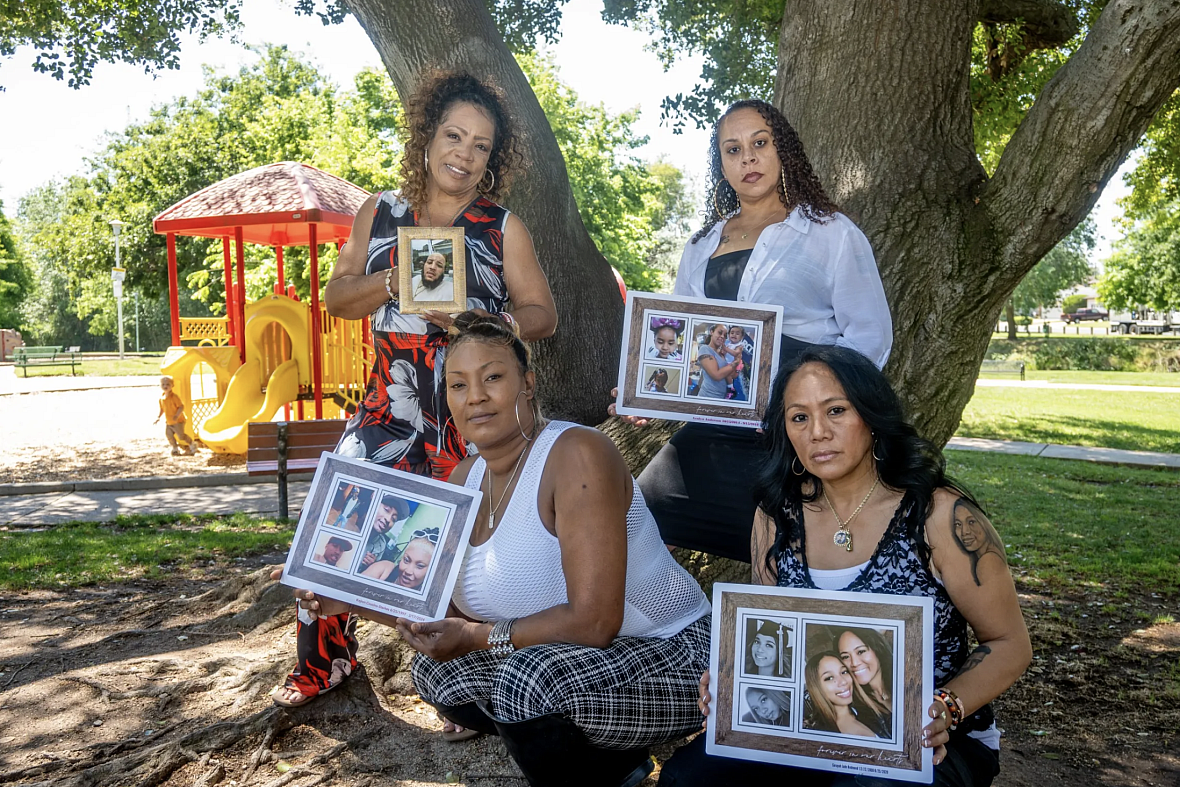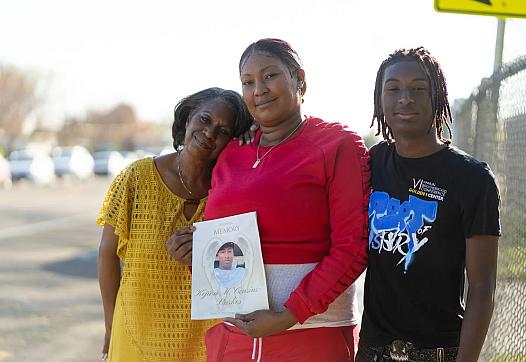An Expert’s View On Why We Die From Gun Violence
The story was originally published in The Observer with support from our 2024 California Health Equity Impact Fund.

From left, Deborah Grimes, Tasha Cousins, Paula Anderson, and Jennifer Redmond all have lost children to gun violence. UC Davis gun violence expert Dr. Garen Wintemute has dedicated his life’s work to reducing gun violence.
Russell Stiger II, OBSERVER
Garen Wintemute, an emergency room doctor at UC Davis Medical Center, sees firsthand the damage gun violence inflicts upon Sacramento.
In a one-week period earlier this month, four incidents resulted in at least three people dying and one in critical condition after being shot, according to Sacramento police.
Wintemute, 72, is a renowned expert on the crisis of gun violence and a pioneer in the field of injury epidemiology and prevention of firearm violence. In more than 40 years conducting research on gun violence and working on its prevention, he has produced an informative body of research on firearm violence that directly improves the health and safety of Americans.

UC Davis gun violence expert Dr. Garen Wintemute has dedicated his life’s work to reducing gun violence.
Louis Bryant III, OBSERVER
In the early 1980s, Wintemute went to Cambodia, saw the homicide rate there, and told himself he needed to do something about violence in the United States.
Wintemute is the first doctor people see when they enter the emergency room at UCD Med Center. Working triage, he attends to as many as 70 patients in an eight-hour shift.
“We see all the gunshot victims in Sacramento if they don’t die at the scene,” Wintemute says. When a patient “hits the door” a team of 10 to 15 people spring into action to treat them.
Between 2019 and 2022, Black people came to the emergency room at three times the rate of white people to be treated for gunshot wounds, according to the California Department of Public Health.
The OBSERVER recently reported that Black people made up a little more than half of the people who died from gun violence in Sacramento County from 2019 through 2023, though they only account for about 11% of the county’s population, according to the U.S. Census.
Wintemute says those numbers are terrible but not surprising. He says the largest increase in homicides in American history took place in 2019 – and that those increases were owing to a widening disparity based on race.
In Sacramento County between 2018 and 2023, 62 people killed by gun violence were age 19 or younger and 34 of those victims were Black, according to reporting by The OBSERVER.
These disparities of Black youth being victims of gun violence existed in rural America too, according to a recent report from the New England Journal of Medicine.
Despite Black youths making up only 10% of the rural population aged 1 to 19 in 2022, they accounted for 30% of firearm-related fatalities among rural youths.
In 2022, for the first time, Black youths in rural communities died by firearms at a rate equal to or higher than in urban communities.
Of the 2,279 firearm-related deaths among Black youths in 2022, nearly 9% occurred among youths residing in rural communities.
The study reveals a critical, overlooked aspect of rising youth mortality: a significant increase of firearm-related deaths among Black rural youths, primarily due to homicides.
“This report said we know about the disparity in urban homicides but look, there is a tremendous race disparity in rural homicide too,” Wintemute says.
When Gun Violence Becomes Routine
Wintemute believes racism is a key factor in making so little progress in preventing gun violence. He says that when people think of firearm violence, they think of interpersonal violence and that demographically, Black and brown people are most at risk for homicide and assault. Racism comes into play when people can look at those demographics and say “‘Not my problem,’” Wintemute says. “So we get nowhere.”
He has encountered people who have said homicide among people of color is not a problem.
“It’s that bad,” Wintemute says. “What you’re finding here in Sacramento County reflects the national experience.”
Wintemute published a study in 2022 that found in California, an estimated 8.9 million adults – more than 1 in 3 – personally know at least one person who has been shot or shot themselves on purpose and 6.3 million know someone whom they perceive to be at risk of violence to themselves or others.
“What we found is people who live in communities with high levels of violence feel the effects of gun violence even if they aren’t directly impacted by gun violence,” Wintemute says.
Two consistent findings are particularly noteworthy. Respondents’ gender was not associated with any experience of violence, a striking contrast with the much-increased risk among men for most forms of violent victimization.
Second, non-owners of firearms who lived with owners reported more prevalent experiences of violence than others did. They were much more likely than firearm owners and non-owners in households without firearms to know persons they perceived to be at risk of violence.
“They said they would walk by memorials regularly or often hear gunfire,” Wintemute says.
Black people were much more likely to know two or more people who were shot than respondents of other racial groups, according to Wintemute’s research.
Ghost Guns: Spookier Than You Think
An added wrinkle in recent years in the battle against gun violence is so-called “ghost guns.” Ghost guns are firearms constructed by private citizens that do not have serial numbers, which means they are not registered. By definition, ghost guns do not appear in law enforcement’s database of persons prohibited from owning firearms and cannot be tracked.
“Ghost guns exist in order to allow people to commit crimes with impunity,” Wintemute says.
One of the most powerful tools in solving gun crimes, he says, is being able to trace ownership of guns. The Bureau of Alcohol, Tobacco and Firearms reported that 30% of firearms it recovered in California were unserialized. At least three mass shootings in California have involved ghost guns.
“If I’m in the business of committing gun crimes, I can fire my gun and throw it away because it’s a ghost gun,” Wintemute says.
He foresees any meaningful policies on a federal level being challenged in court. But in California, policies have been in place to prevent people from getting ghost guns.
According to the California Department of Justice report, across 2020 and 2021, incidents involving ghost guns jumped by about 10,000, from 13,000 to 23,000. However, in 2022, the use of ghost guns decreased to about 21,000 incidents per year.
“What we’re seeing [in California] is a leveling off,” Wintemute says.
The problem is that ghost guns still come into California from other states. Wintemute suggests several specific legislative reforms or administrative actions that, if taken soon, would reduce the risks of gun violence.
“Federal and state governments should prohibit unlicensed manufacture of firearms,” he says. “ATF should establish a clear point, early in the production process, at which unfinished receivers or frames are defined as firearm precursors and further finishing work is defined as manufacturing firearms.”
He also suggests that firearm precursors must be given unique, permanently affixed serial numbers, and that individual production and disposition records be kept.
“The purchase restrictions now in place for fully functional firearms must be applied to firearm precursors,” Wintemute says.
He says owners of the existing stock of ghost guns and unserialized firearm precursors should be required to declare their existence and receive, affix, and record unique serial numbers. After an appropriate delay for implementation, possession of an unserialized firearm or precursor should be a crime, he says, for which a conviction prohibits further ownership or acquisition of firearms, precursors and ammunition.
“The firearm industry operates under a regulatory structure that was largely set in place more than 50 years ago. Time and technology have moved on,” Wintemute says. “Ghost guns pose such a threat, which extends beyond political violence to criminal violence of all types. Produced clandestinely and untraceable, ghost guns are tailor-made for the criminal gun market. Now is the time to do something about them.”
Though he gets discouraged at times, Wintemute’s mission remains the same: to prevent deaths and suffering.
“I’m a doctor; I was a doctor before I was a researcher,” Wintemute says. “I have an obligation to relieve suffering, whether by treating it or preventing it from happening.”


